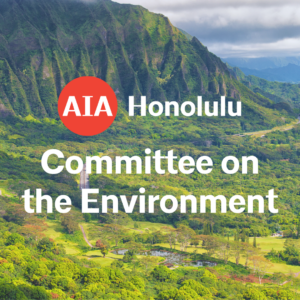Climate Action
AIA’s commitment to climate action
Humanity is faced with a challenge unlike any we have previously encountered: We must take urgent action to reverse the impacts of our greenhouse gas emissions, protect our planet, and preserve life as we know it.
Climate change affects every person, every project, and every client. The impacts are all-inclusive, with no respect for borders or boundaries—and are felt first and hardest by our most vulnerable populations. Rising sea levels, extreme weather events, and the degradation of natural resources are a direct result of increased carbon levels, threatening national security, global economies, and the health, safety, and welfare of local communities. Because more than 40% of U.S. greenhouse gases can be attributed to the building industry—during construction, embodied in concrete, metals, and polymers, and through everyday processes such as heating, cooling, and lighting—architects can lead the change our planet needs. We must take action.
As we launch into the new decade, AIA is prioritizing and supporting urgent climate action to exponentially accelerate the decarbonization of buildings, the building industry, and the built environment by:
- Declaring an urgent climate imperative for carbon reduction.
- Transforming the day-to-day practice of architects to achieve a zero carbon, equitable, resilient, and healthy built environment.
- Leveraging support of all potential partners, including peers, clients, policymakers, and the public.
Click here to continue reading AIA's climate action plan.
Click here to read AIA Nationals "COTE National News latest issue.
The AIA 2030 Commitment
The latest climate data tells us that reducing carbon emissions is not enough. To make the biggest impact, we must all commit to net zero emissions by 2030—a path that requires strong, immediate action. Since the built environment creates a staggering 40% of the world's emissions, architects, engineers, and owners play a key role.
The AIA 2030 Commitment is an actionable climate strategy that gives us a set of standards and goals for reaching net zero emissions in the built environment. More than 1,300 firms have already committed to reaching carbon neutrality by 2030.
Click here to learn more about the 2030 Commitment and how you can join.
Committee on the Environment (COTE)
 The AIA Honolulu Committee on the Environment (COTE) works for architects, allied professionals, and the public to achieve climate action and climate justice through design. We strive to advance, involve, and educate the building community and the public on best design practices and their effects on the environment. We seek to foster community and connections among all in the building sector interested in sustainable design for a healthier, more resilient Hawaii.
The AIA Honolulu Committee on the Environment (COTE) works for architects, allied professionals, and the public to achieve climate action and climate justice through design. We strive to advance, involve, and educate the building community and the public on best design practices and their effects on the environment. We seek to foster community and connections among all in the building sector interested in sustainable design for a healthier, more resilient Hawaii.
COTE Speaker Series
With our Resources and Resourcefulness: Building in Hawaii speaker series, AIA Honolulu COTE is exploring alternatives to business-as-usual building materials and systems, seeking solutions that are regenerative, healthy and carbon sequestering. Anyone who has done the math on shipping or struggled with supply-chain problems can quickly see the many advantages of locally produced goods. These include resilience to global shocks, opportunities for workforce development, GHG emissions reductions, healthy living environments, and more. Yet, in this most remote place on earth known as Hawaii, a place graced with a temperate climate, abundant sunshine and rain, so little of what we build with is truly local, let alone sustainable. We’re asking: What would it take?
- Click here to view a playlist of recorded COTE speaker presentations.
- Visit AIA Honolulu's web calendar to see when the next COTE speaker presentation is taking place.
Design for Risk and Resiliency
The Design for Risk and Resiliency (DfRR) subcommittee addresses issues related to post-disaster (i.e., hurricane), social/political (terrorism), economic/financial, human migration, food security, and a host of other factors that will challenge our resiliency.
- Please email contact@aiahonolulu.org to request access to the DfRR subcommittee's Google Group.
